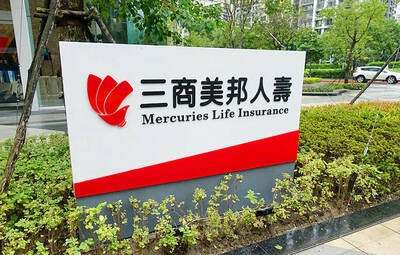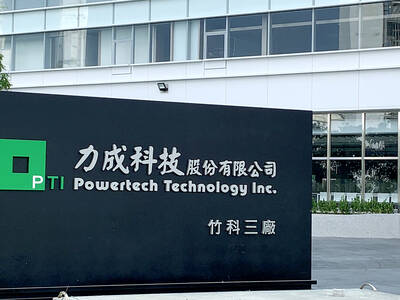The nation’s economy flashed a “yellow-blue” light last month, signaling an economic slowdown despite exports’ robust showing, the Council for Economic Planning and Development said yesterday.
This was the fourth consecutive month the economic indicators shifted downward owing to sluggish private consumption, council officials said.
“The business climate signal turned yellow-blue last month, from a blue light [signaling recession] in July,” Hung Jui-bin (洪瑞彬), director-general of the council’s economic research department, told a media briefing.
Huang said he could not interpret the shift as an improvement since most indicators continued to head down.
The composite leading index stood at 107.5 points last month, down 0.3 percent from July, while the trend-adjusted coincident index dropped 0.9 percent to 109.3 points, Hung said.
The figures reflected downside risks in economic growth, though the indices of customs-cleared exports, industrial production and stock prices gained 1 point each, the economic official said.
Exports, the main driver of the nation’s economic growth, advanced 18.4 percent year-on-year last month, compared with an 8 percent growth a month earlier.
Wu Ming-huei (吳明蕙), an economic analyst at the council, said the stock price index remained in negative territory though the decline eased slightly from July.
Wu said most of the coincident indicators trended downward, led by the large decline in electricity consumption, manufacturing sales and sales index for retail, wholesale and food services.
Looking ahead, Hung said private consumption would be a tough challenge to the government’s efforts to boost the economy as the public continues to shun spending although inflationary pressures have eased significantly.
“Hopefully, the series of economic stimulus measures can reverse the trend in the coming months,” Hung said.
Day Jaw-yang (戴肇洋), a research director at Taiwan Research Institute (台綜院), was not as optimistic.
Day said he could not spot any silver lining in the months ahead given the turmoil in financial markets at home and abroad.
“It will be a blessing if the nation can avoid a further slowdown,” Day said by telephone.
Norman Yin (殷乃平), a money and banking professor at National Chengchi University, agreed.
Citing government statistics, Yin forecast exports would slow in the fourth quarter in light of falling orders from China, the nation’s largest trade partner.
Growth in Taiwan’s export orders slowed to a single digit for a third consecutive month last month as demand from China weakened, the Ministry of Economic Affairs said on Tuesday.
Export orders rose 5.38 percent year-on-year to US$32.13 billion last month, with orders from China and Hong Kong declining 8.86 percent, the ministry said.

Mercuries Life Insurance Co (三商美邦人壽) shares surged to a seven-month high this week after local media reported that E.Sun Financial Holding Co (玉山金控) had outbid CTBC Financial Holding Co (中信金控) in the financially strained insurer’s ongoing sale process. Shares of the mid-sized life insurer climbed 5.8 percent this week to NT$6.72, extending a nearly 18 percent rally over the past month, as investors bet on the likelihood of an impending takeover. The final round of bidding closed on Thursday, marking a critical step in the 32-year-old insurer’s search for a buyer after years of struggling to meet capital adequacy requirements. Local media reports

US sports leagues rushed to get in on the multi-billion US dollar bonanza of legalized betting, but the arrest of an National Basketball Association (NBA) coach and player in two sprawling US federal investigations show the potential cost of partnering with the gambling industry. Portland Trail Blazers coach Chauncey Billups, a former Detroit Pistons star and an NBA Hall of Famer, was arrested for his alleged role in rigged illegal poker games that prosecutors say were tied to Mafia crime families. Miami Heat guard Terry Rozier was charged with manipulating his play for the benefit of bettors and former NBA player and

The DBS Foundation yesterday announced the launch of two flagship programs, “Silver Motion” and “Happier Caregiver, Healthier Seniors,” in partnership with CCILU Ltd, Hondao Senior Citizens’ Welfare Foundation and the Garden of Hope Foundation to help Taiwan face the challenges of a rapidly aging population. The foundation said it would invest S$4.91 million (US$3.8 million) over three years to foster inclusion and resilience in an aging society. “Aging may bring challenges, but it also brings opportunities. With many Asian markets rapidly becoming super-aged, the DBS Foundation is working with a regional ecosystem of like-minded partners across the private, public and people sectors

BREAKTHROUGH TECH: Powertech expects its fan-out PLP system to become mainstream, saying it can offer three-times greater production throughput Chip packaging service provider Powertech Technology Inc (力成科技) plans to more than double its capital expenditures next year to more than NT$40 billion (US$1.31 billion) as demand for its new panel-level packaging (PLP) technology, primarily used in chips for artificial intelligence (AI) applications, has greatly exceeded what it can supply. A significant portion of the budget, about US$1 billion, would be earmarked for fan-out PLP technology, Powertech told investors yesterday. Its heavy investment in fan-out PLP technology over the past 10 years is expected to bear fruit in 2027 after the technology enters volume production, it said, adding that the tech would